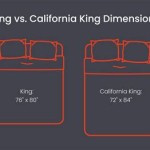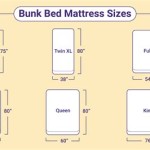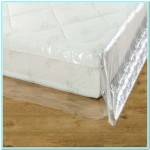What Is a Standard King Size Bed?
The term "standard king size bed" refers to a specific mattress and bed frame dimension that has become a widely recognized and accepted standard within the bedding industry. Understanding the dimensions and characteristics of a standard king size bed is crucial for consumers when making purchasing decisions, ensuring compatibility with bedroom size, and optimizing sleeping comfort. This article delves into the specifics of what constitutes a standard king size bed, covering its dimensions, considerations for bedroom size, advantages, disadvantages, and comparisons to other bed sizes.
Dimensions of a Standard King Size Bed
The officially recognized dimensions of a standard king size mattress are 76 inches wide and 80 inches long. This equates to 6 feet 4 inches in width and 6 feet 8 inches in length. These dimensions are crucial for manufacturers, retailers, and consumers as they establish a consistent baseline for bed frames, bedding (such as sheets and comforters), and overall bedroom planning. The standardized dimensions contribute to ease of purchase and compatibility across different brands and product lines.
It is important to note that while 76 x 80 inches is the *standard* king size, minor variations may occur depending on the manufacturer. These variations are typically within a small margin, usually less than an inch, and generally do not significantly impact the fit of bedding or bed frames designed for a standard king size. However, it is always advisable to verify the exact dimensions with the manufacturer, particularly when purchasing custom-made bed frames or bedding.
The dimensions of the bed frame itself will invariably exceed the mattress dimensions. The exact increase will depend on the style of the bed frame. Platform beds may have minimal increase, while those with headboards, footboards, and side rails will naturally require more space. Therefore, it is crucial to consider the overall footprint of the bed frame when planning bedroom layout.
Bedroom Size Considerations for a King Size Bed
Placing a standard king size bed effectively requires careful consideration of the bedroom's dimensions. A room that is too small can feel cramped and diminish the overall comfort and functionality of the space. While there is no universally accepted minimum bedroom size, a room measuring at least 12 feet by 12 feet is generally recommended to comfortably accommodate a king size bed along with other essential furniture, such as nightstands, dressers, and walking space.
To determine if a bedroom is suitable for a king size bed, one must measure the room's length and width, accounting for any architectural features such as doorways, windows, closets, and built-in shelving. Subtract the space occupied by existing furniture that will remain in the room. Then, consider the additional space required around the bed for comfortable movement and access. A general guideline is to allow at least two feet of space on either side of the bed and at the foot of the bed. This allows for easy access to the bed, making it, and navigating the room.
Consider the placement of bedroom doors. If the door swings inward and obstructs movement around the bed, it may be necessary to reconfigure the room layout or consider a smaller bed size. The placement of windows should also be considered, as they can impact the placement of the headboard and the amount of natural light in the room. A well-planned layout ensures that the king size bed enhances the bedroom's functionality rather than overwhelming it.
Advantages and Disadvantages of a Standard King Size Bed
A standard king size bed offers several advantages. The primary advantage is its ample sleeping space. The 76-inch width provides significant room for two adults to sleep comfortably without disturbing each other, making it an ideal option for couples who prefer more personal space or those who tend to move around during sleep. Furthermore, the extra width accommodates individuals who sleep with children or pets.
The generous size of a king size bed can also enhance the overall aesthetic of a larger bedroom, providing a focal point and contributing to a feeling of luxury and spaciousness. A well-chosen king size bed can elevate the design of the room and create a more inviting and comfortable atmosphere. The wide availability of bedding and accessories for king size beds also provides a wide array of options for personalization and style.
However, standard king size beds also have potential disadvantages. The primary disadvantage is their size, which can make them unsuitable for smaller bedrooms. As previously mentioned, placing a king size bed in a cramped room can make the space feel overwhelming and reduce its functionality. Moving and transporting a king size mattress and bed frame can also be more challenging due to their size and weight. This can be a consideration for those who move frequently or have limited access to their bedroom.
The cost of a standard king size mattress, bed frame, and bedding is typically higher than that of smaller sizes, such as queen or full. This is due to the increased materials required to manufacture these items. However, the investment can be justified by the increased sleeping comfort and longevity of a high-quality king size bed.
Comparison to Other Bed Sizes
Understanding how a standard king size bed compares to other bed sizes is essential for making an informed purchasing decision. The most common comparison is with a queen size bed. A queen size mattress measures 60 inches wide and 80 inches long. This is 16 inches narrower than a standard king size. While a queen size bed can comfortably accommodate two adults, it offers less personal space than a king size. It is a popular choice for couples with smaller bedrooms or those who prefer a more intimate sleeping arrangement.
Another comparison is with a California king size bed. While both are considered "king" size, they differ in dimensions. A California king mattress measures 72 inches wide and 84 inches long. This is 4 inches narrower but 4 inches longer than a standard king. The California king is often preferred by taller individuals who require extra legroom. However, the width difference can be a consideration for couples who value lateral space.
A full size bed, also known as a double bed, measures 54 inches wide and 75 inches long. This is significantly smaller than a king size and is typically suitable for single sleepers or couples who are comfortable sleeping in close proximity. A twin size bed, measuring 38 inches wide and 75 inches long, is designed for single sleepers and is commonly used in children's rooms or guest rooms.
The choice between these different bed sizes depends on individual needs, preferences, and the size of the bedroom. A standard king size bed is generally the best option for couples who prioritize personal space and have a sufficiently large bedroom. However, other sizes may be more appropriate for smaller rooms or single sleepers.
Considerations for Couples with Different Sleep Preferences
Selecting a bed size is particularly important for couples who have differing sleep preferences or habits. A standard king size bed provides ample space to accommodate variations in sleep styles, such as differences in temperature preferences, sleep schedules, or sensitivity to movement. Couples who tend to toss and turn during the night or who have different wake-up times may benefit from the extra space offered by a king size bed, as it minimizes the likelihood of disturbing each other's sleep.
Mattress firmness is another critical consideration for couples. If one partner prefers a firmer mattress while the other prefers a softer one, a king size bed offers the option of using two separate twin XL mattresses placed side-by-side. This allows each partner to select a mattress with their preferred firmness level. This approach is particularly beneficial for couples with significant discrepancies in their weight or spinal alignment needs.
Furthermore, the use of separate bedding, such as individual blankets or comforters, can further enhance sleeping comfort for couples with different temperature preferences. The ample width of a king size bed provides sufficient space for each partner to customize their bedding without impacting the other person's sleep. This level of customization is often not possible with smaller bed sizes.
Bed Frame Selection for a Standard King Size Mattress
Selecting the appropriate bed frame is crucial for providing adequate support for a standard king size mattress and ensuring its longevity. The bed frame should be specifically designed to accommodate the dimensions and weight of a king size mattress. A poorly constructed or ill-fitting bed frame can lead to premature wear and tear of the mattress, resulting in sagging, uneven support, and reduced comfort.
Common types of bed frames for king size mattresses include platform beds, which provide a solid, level surface for the mattress without the need for a box spring; slatted bed frames, which consist of wooden or metal slats that provide support and ventilation; and box spring foundations, which are typically used in conjunction with traditional mattresses to provide additional support and height.
The choice of bed frame material and construction should be based on individual preferences and the overall aesthetic of the bedroom. Solid wood frames are durable and provide a classic look, while metal frames are often more lightweight and offer a modern appearance. Upholstered bed frames can add a touch of luxury and comfort to the bedroom. Regardless of the material, it is crucial to ensure that the bed frame is sturdy and capable of supporting the weight of the mattress and its occupants.
Consider the height of the bed frame. Taller bed frames can make it easier to get in and out of bed, while lower bed frames may create a more modern and minimalist look. The height of the bed frame should be chosen based on individual comfort and accessibility needs. It is also important to ensure that the bed frame is compatible with the height of the nightstands and other bedroom furniture.

Mattress Sizes Uk Guide For Perfect Bedroom Fit

Bed Sizes Guide Curtain Of Maine

Mattress Sizes Chart Bed Dimensions Guide Purple

Wfmo S Guide To Standard Non Mattress Sizes
Ka 01003 A H Beard

Mattress Sizes Chart

Diffe King Size Beds 8 Sizes Curly On The Market

King Size Bed Dimensions Guide Dreamcloud

Bed Sizes In Malaysia A Comprehensive Guide 2024 Frwd By Cuura Space

Mattress Sizes And Dimensions Guide To See More Read It








